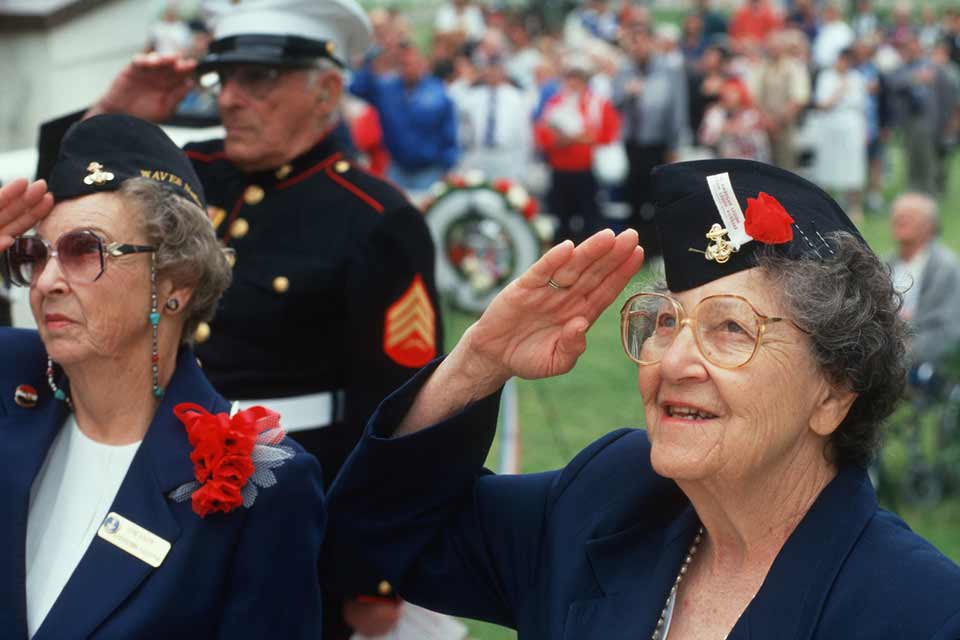Make the best senior care decision

A Guide to the VA Aid and Attendance Benefit

When it comes to paying for senior living, many older adults remain unaware of the options available. This rings especially true for one payment source: the Department of Veterans Affairs (VA) Aid and Attendance program.
Let our care assessment guide you
Our free tool provides options, advice, and next steps based on your unique situation.
In this Article
More than 8.5 million veterans are projected to be age 65 or older as of September 2022, according to the latest VA statistics. While the longstanding VA Aid and Attendance benefit can cover thousands each year in a veteran’s senior living and caregiving expenses, only an estimated quarter of eligible seniors apply.
“Many people fail to apply because they assume they’re not eligible,” says Suzette Graham, founder and CEO of Patriot Angels, a trusted partner of A Place for Mom.
In truth, eligibility may be less restrictive than you think. Countless veterans and survivors are unaware the VA Aid and Attendance benefit exists, but once they learn about the benefit, they say it sounds too good to be true.
Learn more about VA Aid and Attendance, and discover if it can help you or your senior loved one pay for elder care costs.
Learn all about VA benefits
A Place for Mom’s all-in-one veterans resource helps veterans and their families compare long-term care benefits, determine eligibility, and start the application process.
Download the VA benefits guide >
What is VA Aid and Attendance?
VA Aid and Attendance provides a substantial monthly payment on top of existing VA pensions for eligible veterans and surviving spouses. This supplemental income is added to the VA Pension or Survivors Pension to help cover the cost of long-term senior care.
What types of senior care does the VA Aid and Attendance benefit cover?
Older veterans or their surviving spouses who can no longer manage their care independently can use VA Aid and Attendance benefits to help cover the cost of assisted living, memory care, a nursing home, or in-home care services.
According to Graham, any senior living community can help a veteran or their surviving spouse so long as that community provides 24-hour staffing and the veteran requires assistance with at least two of the six activities of daily living (ADLs) allowed by the VA.
Who is eligible for VA Aid and Attendance?
A veteran must already be a senior living resident or have an in-home caregiver to apply for VA Aid and Attendance. Secondly, to receive a VA Aid and Attendance benefit, you or your senior loved one must first be receiving the basic VA pension, or you or they must apply for VA pension at the same time as applying for VA Aid and Attendance. To qualify for the basic VA pension, veterans must meet all of the following requirements:
- They must not have been dishonorably discharged.
- They must have served on active duty before Sept. 8, 1980, for at least 90 days, with at least one day during wartime, or served on active duty after Sept. 7, 1980, for 24 months, with at least one day during wartime.
- They must be at least 65, have a permanent disability, live in a nursing home due to a disability, or receive Social Security Disability or Supplemental Security Income.
Service requirements
The VA considers the following as wartime periods:
Mexican Border period: May 9, 1916 – April 5, 1917
World War I: April 6, 1917 – November 11, 1918
World War II: December 7, 1941 – December 31, 1946
Korean conflict: June 27, 1950 – January 31, 1955
Vietnam War Era: February 28, 1961 – May 1975 for veterans who served in the Republic of Vietnam; August 5, 1964 – May 7, 1975 for other veterans

Let our care assessment guide you
Our free tool provides options, advice, and next steps based on your unique situation.
Gulf War: August 2, 1990 – future date to be determined by law or a presidential order
Financial Requirements
To qualify for VA benefits, the veteran’s net worth must fall
below $138,489. This limit set by Congress lasts until November 30, 2022, and the limit may change annually. Your loved one’s net worth includes the following:
- Annual income, including salary, bonuses, commissions, tips, Social Security benefits, retirement payments, and any income a spouse or dependents may receive.
- Assets, including personal property like land and investments, but excluding your loved one’s primary home and vehicle (not counted as an asset).
However, certain expenses may be deducted from the veteran’s income and assets when calculating their net worth, such as cost of senior care, medical expenses that aren’t reimbursed, Medicare premiums or Medicare supplemental premiums, or products or services prescribed by a doctor.
Learn more about qualification requirements in our article, “VA Benefits Financial Eligibility: Who Qualifies for Veterans Long-Term Care Benefits?”
Clinical Requirements
In addition to these VA pension requirements, a veteran’s situation must fit one of the following descriptions to be eligible for the additional Veterans Aid and Attendance benefit:
- The veteran needs a caregiver to assist with activities of daily living (ADLs), like dressing, showering, or toileting.
- The veteran is bedridden as the result of an illness.
- The veteran lives in a nursing home due to a physical or cognitive disability.
- The veteran’s vision is 5/200 or less in both eyes or the veteran has a visual field of 5 degrees or fewer.
How are VA benefits for senior care paid?
A VA pension with an upgrade of Aid and Attendance is most commonly awarded through direct deposit to the veteran or survivor’s bank account, says Graham. There are credit unions and veteran-friendly banks for any person who doesn’t have a bank account but wishes to receive their payment through direct deposit. Beneficiaries who don’t have a bank account and don’t wish to use direct deposit must receive payment through a Direct Express Debit Mastercard.
How do veterans apply to the VA Aid and Attendance program?
Veterans can apply through the mail or in person. They will need to download the VA Aid and Attendance form, VA Form 21-2680. Section III, the examination information section, needs to be completed by the applicant’s doctor. Veterans can complete Sections I and II of the form independently, or they may take it to a VA regional office for assistance. Either way, seniors should have the following important information ready:
- Social security number
- VA file number
- Veteran’s service number
Additional forms to support your application
Though not required, including a doctor’s report on the applicant’s medical condition can help support their application.
If a veteran or their surviving spouse lives in a nursing home, they’ll need to download and complete the official Request for Nursing Home Information in Connection with Claim for Aid and Attendance form.
Seniors can also send details about their day-to-day lives, such as how a disability affects their routine or causes difficulties with transportation. However, this is typically not necessary and can prolong the application response time.
Where can I find help?
While veterans and their families can complete a successful application on their own, sometimes trained help is needed. A Place for Mom’s Senior Living Advisors can answer general questions about VA Aid and Attendance, and they can refer to trusted, VA-accredited consultant partners for help in filling out the application.
Veterans’ organizations like the VFW, American Legion, and Disabled American Veterans (DAV), which have local posts and chapters in most cities, provide assistance filling out Aid and Attendance forms for no cost.
Elder law attorneys can also assist veterans and their families with their application. The VA maintains a free, online database to help veterans find VA-accredited attorneys in their state.
Get expert advice from A Place for Mom’s trusted, VA-accredited partners.
Choose from:
- Elder Veterans Legal Aid Group, P.C. (800-878-2149)
- Patriot Angels (1-833-879-6017)
Note: A Place for Mom may be compensated if you choose to use Patriot Angels’ services. Per our editorial guidelines, we clearly disclose financial relationships around featured products or services.
When do veterans find out if they qualify for VA Aid and Attendance?
In rare, best-case scenarios, checks for monthly benefits come within 60 days of submitting an application. Other times, the wait can range from 10 to 12 months. Veterans 85 and older may experience a shorter wait if they are granted “priority processing” by the VA.
The good news? Once the VA confirms a veteran or their surviving spouse is eligible for Aid and Attendance, they’ll receive retroactive payments covering the previous months when the application was pending. For a veteran to receive retroactive payments, they’ll need to fill out an Intent to File form. This form should be filled out at the beginning of the process and can be submitted while you are collecting other information for the application.
VA Housebound benefits
VA Housebound benefits are designed to help permanently disabled veterans receive care while they’re confined to their homes. Similar to VA Aid and Attendance benefits, the veteran must first meet eligibility requirements and be receiving a VA pension or Survivors Pension to qualify for Housebound benefits.
Veterans may be eligible for housebound benefits if they receive a monthly VA pension; have a permanent, service-related disability; and spend nearly all their time at home for health reasons. However, veterans can’t receive this benefit and Aid and Attendance at the same time.
A VA pension with an upgrade of the Housebound benefit can be difficult to receive, says Graham. For instance, only 131 applications for Housebound benefits were approved by the VA in 2020. However, this shouldn’t stop someone from applying. The VA Housebound benefit money can be used at the veteran’s discretion once they qualify and is a great option for any veteran seeking care from the comfort of their own home.
Please consider your financial needs carefully when deciding between VA Housebound and Aid and Attendance benefits: VA Aid and Attendance often provides a higher financial benefit than VA Housebound benefits do.
VA Benefits and Long-Term Care Guide
The VA Aid and Attendance program helps with senior living and in-home care affordability — making daily assistance more attainable for many veterans and their families. For more information, download our VA Benefits and Long-Term Care: Guide to Aid & Attendance e-book.
This article is for informational purposes only. A Place for Mom doesn’t provide legal advice for benefits applications. For professional legal advice, please consult with a VA-accredited claims representative.
Sources
U.S. Department of Veterans Affairs. VA Aid and Attendance benefits and Housebound allowance.
U.S. Department of Veterans Affairs. Eligibility for Veterans Pension.
The information contained in this article is for informational purposes only and is not intended to constitute medical, legal or financial advice or create a professional relationship between A Place for Mom and the reader. Always seek the advice of your health care provider, attorney or financial advisor with respect to any particular matter and do not act or refrain from acting on the basis of anything you have read on this site. Links to third-party websites are only for the convenience of the reader; A Place for Mom does not recommend or endorse the contents of the third-party sites.